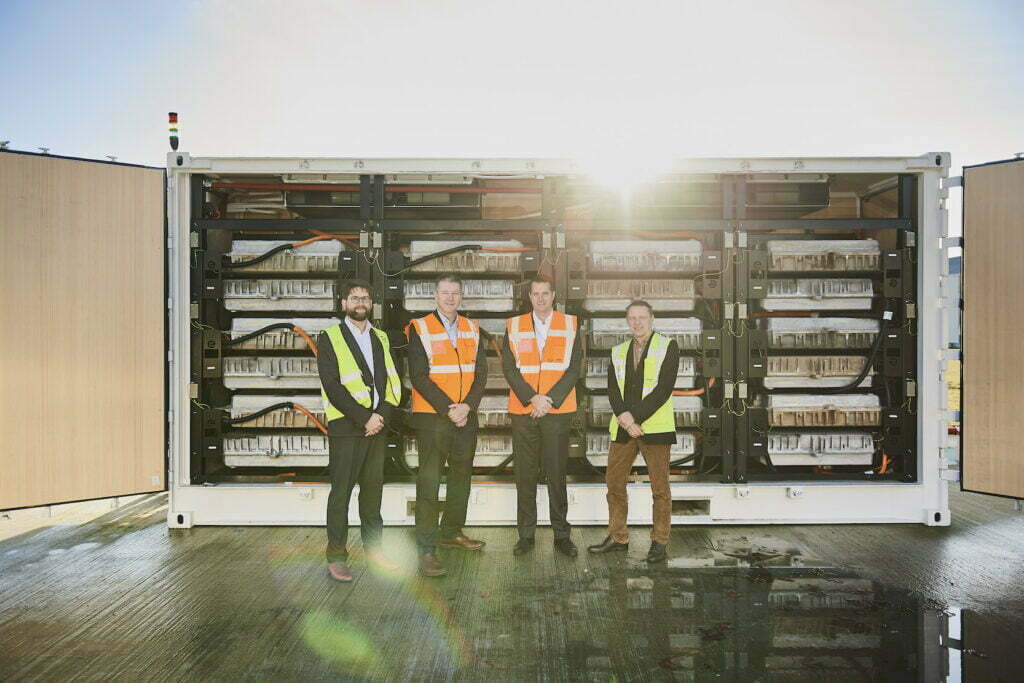ESS Inc Energy Warehouse unit for large commercial and industrial applications. Image: ESS Inc via Twitter.
Recently announced deals and partnerships in the California and Australia markets are a taste of the future ahead, ESS Inc has claimed.
The US company is the world’s only manufacturer of flow batteries that use an all-iron and saltwater electrolyte. It just published its Q3 2022 financial results, having been publicly listed in late 2021.
ESS Inc is currently on the path to commercialise its products, aimed at the long-duration energy storage market for applications of between about six and 14 hours. It only began recognising revenues in the second quarter of this year, and said prior to its listing that profitability would likely be at least a couple of years away.
In Q2, it recognised US$686,000 revenues from three units sold and installed of its 400kWh Energy Warehouse commercial and industrial (C&I) storage solution. In Q3, it recognised US$189,000 revenue from one unit shipped.
The third quarter revenue figure is significant, ESS Inc CEO Eric Dresselhuys said, because the company has been working hard to reduce the time between producing and shipping Energy Warehouse or the larger Energy Center units and recognising revenues.
In this case, revenues were recognised within the three-month period the order was placed and the client, installer Terrasol and its customer Sycamore International, have made a follow-on order for a second unit at the site.
Also significant is that ESS Inc expects to exceed its targeted 750MWh of annual production capacity from its existing production lines in Pennsylvania, which are currently being fitted out with semi-automated and then fully automated battery module lines by the end of this year. Dresselhuys claimed the company could ship around 20 more units before the end of 2022.
CFO Amir Moftakhir said that ESS Inc wants to speed up the revenue recognition process further, while also implementing cost reduction measures.
While the company ended Q3 with an adjusted EBITDA of -US$24 million, there is expected to be “ample liquidity to run the business” and ESS Inc should finish the year with more than US$120 million in cash and cash equivalents.
‘Unprecedented catalyst to the market’
As reported by Energy-Storage.news, ESS Inc signed a deal with California municipal utility Sacramento Municipal Utility District (SMUD) to provide up to 200MW/2,000MWh of iron flow batteries in September.
CEO Dresselhuys noted that SMUD’s targeted net zero emissions date is 2030, 15 years earlier than the state of California’s target date. With SMUD providing electricity to about 1.5 million customers, other utilities will quickly realise the value of long-duration energy storage (LDES) and follow its example, Dresselhuys said on a call to explain financial results.
Also during the quarter, ESS Inc cemented a deal for its batteries to be shipped and sold in Australia, before the technology is then licensed for manufacturing and sale locally. Partner Energy Storage Industries Asia-Pacific (ESI) will distribute and manufacture Energy Warehouse units for the Australia, New Zealand and Oceania markets.
Starting with delivery of 70 units this year and next, ESI, will then build its own iron flow battery factory in Queensland by 2024.
Dresselhuys said that as regions with high renewable energy penetration, Australia and California are a little ahead of the adoption curve for energy storage, but that other markets around the world will start to look similar.
Together with the SMUD deal, the ESI partnership creates “a meaningful base of business” for ESS Inc, the CEO said.
Within the US market, the Inflation Reduction Act (IRA) is expected to have a “transformative impact,” Dresselhuys said. Customers should be able to avail of a 30% baseline investment tax credit (ITC), paired with a 10% bonus for using American-made ESS Inc batteries.
If sited in an economic or energy development zone, projects could get up to 50% credit and coupled with local grants could add up to savings approaching two-thirds the cost in some instances.
ESS Inc products will also be eligible for production tax credits (PTC) of about US$45/kWh shipped. Dresselhuys called the combination of incentives an “unprecedented catalyst to our market”.
In a recent interview with this site at the RE+ 2022 trade show in California, ESS Inc’s senior VP for business development and sales Hugh McDermott said demand for flow batteries is reaching an inflection point.
“There’s no major market, anywhere in the world, where there’s not major players that have reached out and want to know more about what long duration storages are, about our technology and our capability,” McDermott said.
ESS Inc announced another California deal a few days ago: the company will provide a 75kW/500kWh Energy Warehouse to an ‘ecocampus’ owned by municipal water company Burbank Water and Power. It will be paired with a 265kW solar PV array on the facility’s rooftop.
Energy-Storage.news’ publisher Solar Media will host the 5th Energy Storage Summit USA, 28-29 March 2023 in Austin, Texas. Featuring a packed programme of panels, presentations and fireside chats from industry leaders focusing on accelerating the market for energy storage across the country. For more information, go to the website.
Continue reading









